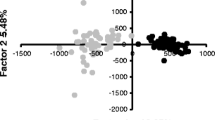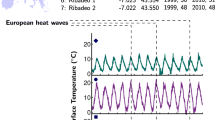Abstract
Genetic diversity and genetic structure in a population of the brown seaweed Halidrys dioica Gardner were evaluated in five sites in southern California, USA, in 1991, using isozyme electrophoresis. H. dioica is relatively long-lived and has an outcrossing mating system and floating reproductive fronds with the potential for longdistance gamete dispersal. Because these characteristics are hypothetically important in determining genetic diversity and structure, we predicted that genetic diversity would be high and genetic structure would be exhibited only at relatively large geographic scales in H. dioica populations. The data were consistent with the prediction: genetic diversity (% polymorphic loci, no. of alleles/locus, average expected heterozygosity) was high compared to that of other seaweed species. Genetic structure (Wright's F statistics, Nei's genetic distance, point-pattern analysis of alleles) was low within and among distinct rocky reefs over 4 km of coast but high in subpopulations separated by 90 km. Life-history characteristics may be useful predictors of genetic diversity and structure in seaweed populations, but information on selection regimes, long-distance dispersal, and the extent of clonal propagation, for example, are critically lacking.
Similar content being viewed by others
References
Abbott IA, Hollenberg GJ (1976) Marine algae of California. Stanford University Press, Stanford
Ayre DJ (1983) The effects of asexual reproduction and inter-genotypic aggression on the genotypic structure of populations of the sea anemone Actina tenebrosa. Oecologia 57:158–165
Benzie JAH, Stoddart JA (1992) Genetic structure of crown-of-thorns starfish (Acanthaster planci) in Australia. Mar Biol 112: 631–639
Bhattacharya D, Baillie DL, Druehl LD (1990) Population analysis of the kelp Costaria costata (Phaecophyta) using a polymorphic ribosomal DNA probe. Pl Syst Evol 179:177–191
Bolton JJ (1983) Ecoclinal variation in Ectocarpus siliculosus (Phaeophyceae) with respect to temperature growth optima and survival limits. Mar Biol 73:131–138
Boots BN, Getis A (1988) Point pattern analysis: scientific geography series. SAGE Publications, Beverly Hills
Brawley SH, Johnson LE (1991) Survival of fucoid embryos in the intertidal zone depends on developmental stage and microhabitat. J Phycol 27:179–186
Cheney DP, Babbel GR (1978) Biosystematic studies of the red algal genus Eucheuma. I. Electrophoretic variation among Florida populations. Mar Biol 47:251–264
Cressie NAC (1991) Statistics for spatial data. John Wiley & Sons, Inc, New York
Crowe FJ, Schwartzlose RA (1972) Release and recovery records of drift bottles in the California Current region, 1955 through 1971. Calif coop ocean Fish Invest Atlas 16:1–140
Dethier MN, Duggins DO, Mumford TF (1989) Harvesting of nontraditional marine resources in Washington state: trends and concerns. NW envirl J 5:71–87
Deysher L, Norton TA (1982) Dispersal and colonization in Sargassum muticum (Yendo) Fensholt. J exp mar Biol Ecol 56:179–195
Diggle PJ (1983) Statistical analysis of spatial point patterns. Academic Press, London
Druehl LD, Kemp L (1982) Morphological and growth responses of geographically isolated Macrocystis integrifolia populations when grown in a common environment. Can J Bot 60:1409–1413
Fritsch FF (1965) The structure and reproduction of the algae, Volume II. Cambridge University Press, London
Fujio Y, Kodaka PL, Hara M (1985) Genetic differentiation and amount of genetic variability in natural populations of the haploid laver Porphyra yezoensis. Jap J Genet 60:347–354
Fujio Y, Tanaka MY, Hara M, Akiyama K (1987) Enzyme polymorphism and population structure of the haploid laver Porphyra yezoensis. Nippon Suisan Gakk 53:357–362
Gerard VA (1988) Ecotypic differentiation in light-related traits of the kelp Laminaria saccharina. Mar Biol 97:25–36
Gerard VA (1990) Ecotypic differentiation in the kelp Laminaria saccharina: phase-specific adaptation in a complex life cycle. Mar Biol 107:519–528
Gerard VA, Du Bois KR (1988) Temperature ecotypes near the southern boundary of the kelp Laminaria saccharina. Mar Biol 97:575–580
Getis, A (1984) Interaction modeling using second-order analysis. Environment Plann A 16:173–183
Getis A, Franklin J (1987) Second-order neighborhood analysis of mapped point patterns. Ecology 68(3):473–477
Hamrick JL, Godt ML (1990) Allozyme diversity in plant species In: Brown AHD, Clegg MT, Kahler AL, Weir BS (eds) Plant population genetics, breeding, and genetic resources. Sinauer Associates, Sunderland, pp 43–63
Hamrick JL, Linhart YB, Mitton JB (1979) Relationships between life history characteristics and electrophoretically detectable variation in plants. A Rev Ecol Syst 10:173–200
Hardin, G (1968) Tragedy of the commons. Science, NY 162: 1243–1248
Hillis DM, Moritz C (1990) Molecular systematics. Sinauer Associates, Sunderland
Hungerford L (1988) SECSIM: a FORTRAN program for secondorder analysis. University of Illinois, Department of Veterinary Pathology Urbana, Illinois
Hutchings MJ (1979) Standing crop and pattern in pure stands of Mercurialis perennis and Rubus fruticosus in mixed deciduous woodland. Oikos 31:351–357
Innes DJ (1984) Genetic differentiation among populations of marine algae. Helgoländer Meeresunters 38:401–417
Johnson MS, Black R (1984) Pattern beneath the chaos: the effect of recruitment on genetic patchiness in an intertidal limpet. Evolution 38:1371–1383
Karl SA, Avise JC (1992) Balancing selection at allozyme loci in oysters: implications from nuclear RFLPs. Science, NY 256:100–102
Kendrick GH, Walker DI (1991) Dispersal distances for propagules of Sargassum spinuligerum (Sargassaceae: Phaeophyta) measured directly by vital staining and Venturi suction sampling. Mar Ecol Prog Ser 79:133–138
Lessions HA (1992) Testing electrophoretic data for agreement with Hardy—Weinberg expectations. Mar Biol 112:517–523
Levin DA (1978) Some genetic consequences of being a plant. In: Brussard PF (ed) Ecological genetics: the interface. Springer-Verlag, New York, pp 189–219
Levin DA (1988) Local differentiation and the breeding structure of plant populations. In: Gottlieb LD, Jain SK (eds) Plant evolutionary biology. Chapman & Hall, New York, pp 305–329
Loveless MD, Hamrick JL (1984) Ecological determinants of genetic structure in plant populations. A Rev Ecol Syst 15:65–95
Macaranas JM, Ablan CA, Pante MRJ, Benzie JAH, Williams ST (1992) Genetic structure of giant clam (Tridacna-derasa) populations from reefs in the Indo-Pacific. Mar Biol 113:231–238
Malinowski K (1974) Codium fragile: the ecological and population biology of a colonizing species. Ph. D. dissertation. Yale University, New Haven
Mathieson AC, Norton TA, Neushul M (1981) The taxonomic implications of genetic and environmentally induced variations in seaweed morphology. Bot Rev 47:313–347
Mitton JB, Linhart YB, Sturgeon KB, Hamrick JL (1979) Allozyme polymorphism detected in mature needle tissue of ponderosa pine. J Hered 70:86–89
Miura W, Fujio Y, Suto S (1979) Genetic differentiation between the wild and cultured populations of Porphyra yezoensis. Tohoku J agric Res 30:114–125
Murray SN, Littler MM (1989) Seaweeds and seagrasses of Southern California: distributional lists for twenty-one rocky intertidal sites. Bull Sth Calif Acad Sci 88:61–79
Nei M (1972) Genetic distance between populations. Am Nat 106:283–292
Rossi RE, Mulla DJ, Journel AG, Franz EH (1992) Geostatistical tools for modeling and interpreting ecological spatial dependence. Ecol Monogr 62:277–314
Russell G, Fielding AH (1981) Individuals, populations, and communities. In: Lobban CS, Wynne MJ (eds) The biology of seaweeds. Blackwell, Oxford, pp 393–420
Schwartzlose RA (1963) Nearshore currents of the western United States and Baja California as measured by drift bottles. Rep Callif coop oceanic Fish Invest 9:15–22
Sokal RR, Oden NL (1978) Spatial autocorrelation in biology. 1. Methodology. Biol J Linn Soc 10:199–228
Sosa PA, Garcia-Reina G (1992) Genetic variability and differentiation of sporophytes and gametophytes in populations of Gelidium arbuscula (Gelidiaceae: Rhodophyta) determined by isozyme electrophoresis. Mar Biol 113:679–688
Sosa PA, Garcia-Reina G (1993) Genetic variability in Gelidium canariensis (Rhodophyta) determined by isozyme electrophoresis. J Phycol 29:118–124
Strauss DJ (1975) A model for clustering. Biometrika 62:467–475
Stewart JG (1991) Marine algae and seagrasses of San Diego County. California Sea Grant College, La Jolla
Stickle WB, Foltz DW, Katoh M, Nguyen HL (1992) Genetic structure and mode of reproduction in five species of sea star (Echinodermata: Asteroidea) from the Alaskan coast. Can J Zool 70: 1723–1728
Swofford DL, Selander RB (1981) BIOSYS-1: a FORTRAN program for the comprehensive analysis of electrophoretic data in population genetics and systematics. J Hered 72:281–283
Tibby RB (1939) Report on returns of drift bottles released off Southern California, 1937. Calif Fish Game, Fish Bull 55:5–39
Todd CD, Thorpe JP, Hadfield MG (1991) Genetic structure of populations of the aplysiid opisthobranch Stylocheilus longicaudus (Quoy & Gaimard) around the shores of O'Ahu, Hawaii. J mollusc Stud 57:153–166
Tracey ML, Bellet NF, Gravem CD (1975) Excess allozyme homozygosity and breeding population structure in the mussel Mytilus californianus. Mar Biol 32:303–311
Wahlund S (1928) Zusammensetzung von Populationen und Korrelationserscheinungen vom Standpunkt der Vererbungslehre aus betrachtet. Hereditas 11:65–106
Weir BS, Cockerham CC (1984) Estimating F-statistics for the analysis of population structure. Evolution 38:1358–1370
Williams GC, Koehn RK, Mitton JB (1973) Genetic differentiation without isolation in the American eel, Anguilla rostrata. Evolution 27:192–204
Wright S (1978) Evolution and the genetics of populations. Volume IV. Variability within and among populations. University of Chicago Press, Chicago
Author information
Authors and Affiliations
Additional information
Communicated by M. F. Strathmann, Friday Harbor
Rights and permissions
About this article
Cite this article
Lu, T.T., Williams, S.L. Genetic diversity and genetic structure in the brown alga Halidrys dioica (Fucales: Cystoseiraceae) in Southern California. Marine Biology 121, 363–371 (1994). https://doi.org/10.1007/BF00346746
Received:
Accepted:
Issue Date:
DOI: https://doi.org/10.1007/BF00346746




